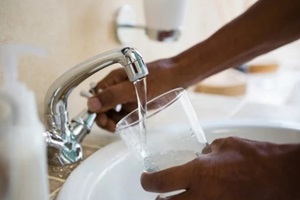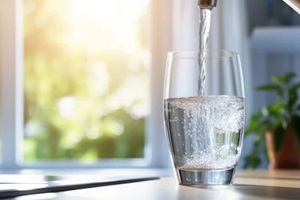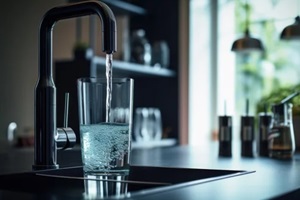 It’s easy to assume that tap water is safe to drink. After all, it’s subjected to various treatments by local water authorities before it reaches your home.
It’s easy to assume that tap water is safe to drink. After all, it’s subjected to various treatments by local water authorities before it reaches your home.
Tap water contains various contaminants that may cause health problems, affect the water’s taste and odor, or damage water appliances and plumbing work.
Below is an overview of common contaminants found in tap water and how water filtration and softening systems can help improve purity.
Types of Contaminants Found in Tap Water
Tap water contaminants can be classified into microbial, chemical, and physical.
Microbial or Biological Contaminants
These are disease-causing microorganisms that enter water supplies through untreated sewage. Examples include bacteria, viruses, and parasites. While most municipal water systems are treated with chlorine to kill these microorganisms, some may still slip through the cracks and end up in tap water.
Chemical Contaminants
Chemical contaminants mostly originate from industrial and agricultural runoff, volcanic ash, aging plumbing, or improper waste disposal. They include heavy metals such as lead, arsenic, nitrate, and pesticides.
Physical Contaminants
Physical contaminants are non-dissolved particles that may affect the taste and appearance of water. These include sediment, rust, and particles from corroded pipes or soil erosion.
Impact of Tap Water Contaminants
When ingested or upon contact with skin, tap water contaminants may cause various health problems.
- Microbial contaminants cause gastrointestinal illnesses such as diarrhea, vomiting, and stomach cramps.
- Respiratory infections may result from microbial contaminants.
- Skin irritation and eye problems can be caused by any type of contaminant.
- Chemical contaminants may cause long-term health problems such as cancer, neurological issues, developmental problems in children, and reproductive problems.
- Chemical contaminants can trigger allergic reactions or sensitivities, leading to itching, hives, and breathing difficulties.
Besides health effects, chemical contaminants can cause water hardness, leading to appliance damage, high electricity bills, decreased soap efficiency, and clogged pipes. Physical pollutants can also affect the taste and appearance of water.
Unique Contaminants in Hawaii’s Water
 Each location is highly exposed to certain contaminants based on geography and industrial activities. For instance, tap water in highly industrialized areas may contain higher chemical pollutants due to industrial waste. Hawaii’s geography makes it highly susceptible to chemical pollutants.
Each location is highly exposed to certain contaminants based on geography and industrial activities. For instance, tap water in highly industrialized areas may contain higher chemical pollutants due to industrial waste. Hawaii’s geography makes it highly susceptible to chemical pollutants.
For over 70 million years, the state’s landscape has been shaped by volcanic eruptions that leave behind volcanic ash — tiny particles of pulverized rock and glass containing heavy metals such as mercury, arsenic, and lead, among other chemical pollutants.
These contaminants can find their way into water sources through rainwater or groundwater runoff, causing contamination. Hawaii is also home to large-scale agricultural activities involving pesticides, herbicides, and fertilizers. These also contaminate water sources through runoff.
Water Filtration Solutions for Hawaii’s Water
Owing to the unique contaminants found in Hawaii’s water, homeowners should invest in a reliable and customized water filtration and softening system.
Here are some options that can help remove pollutants from Hawaii’s tap water:
Reverse Osmosis Systems
RO systems use a membrane with microscopic pores to filter out tiny particles and dissolved solids such as heavy metals, pesticides, and chemicals.
These systems can remove up to 99% of impurities in Hawaii’s tap water, making it safe for drinking. They are also effective in eliminating volcanic ash contaminants.
Granular Activated Carbon Filters
GAC filters use carbon to absorb impurities and contaminants from water. They can be particularly effective in reducing chlorine, lead, and other chemical pollutants found in Hawaii’s tap water.
They also eliminate unpleasant odors and improve the taste of water.
Ultraviolet Filters
These systems use UV lights to disinfect water by killing microorganisms such as bacteria and viruses. This is particularly important for areas where microbial contaminants are a concern, such as Hawaii.
Water Softeners
Although Hawaii generally doesn’t have a significant issue with hard water compared to many other regions, it’s worth considering a water softener.
This prevents limescale buildup in appliances, thereby helping improve their lifespan. Water softening systems use ion exchange technology to replace limescale-forming ions with sodium ions.
Choosing the Right Water Filtration System
Selecting a water filtration system involves many considerations, owing to the vast array of options available. Homeowners should consider the following factors:
 The contaminants present in their tap water
The contaminants present in their tap water- Their budget and maintenance costs for different systems
- Desired flow rate and water pressure
- The size of the household or commercial property
- Certification by independent agencies such as NSF International to ensure system efficiency
Protect Your Health With Water Filtration from Hawaiian Cool Water
Hawaiian Cool Water has been helping Hawaii residents and businesses access clean, safe, and delicious drinking water for over a decade. As a local business, its water filtration and softening systems are highly customized to meet the purification needs of Hawaii’s water.
Contact Hawaiian Cool Water today for reliable, affordable, and effective water filtration solutions.


